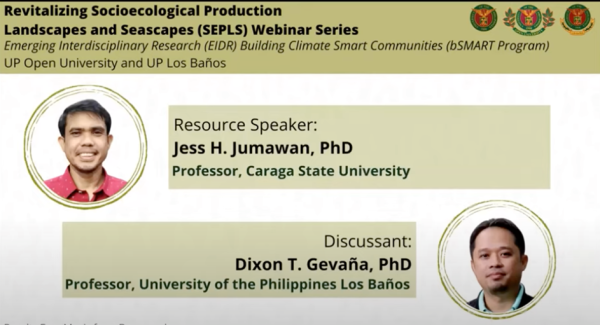The 7th installment of the Revitalizing Socio-ecological Production Landscapes and Seascapes (SEPLS) webinar series was held on 29 September 2022. It showcased the presentation titled “ Preliminary Flora and Fauna Assemblage in one of the Satoyama-Satoumi Program sites in Butuan City, Agusan Del Norte, Philippines” by Dr. Jess Jumawan, Professor, Caraga State University. The event was also graced by Dr. Dixon T. Gevaña, Professor, University of the Philippines Los Baños as the discussant. Satoyama-Satoumi refers to the study of interactions between humans and terrestrial-aquatic landscapes ecosystem (satoyama) and marine coastal ecosystems (satoumi) (IPBES, n.d.).
Dr. Jumawan stated that Butuan City in Agusan Del Norte is one of the areas that are vulnerable to climate change. The city sits below sea level and is bounded to the northwest by Butuan Bay, making it highly susceptible to flooding. Satoyama and Satoumi landscapes are also present in Butuan City due to its area that has close interaction between the people and nature, the presence of mosaic villages, mixed forests, farmlands, grasslands, ponds, streams, and irrigation canals.
Furthered by Dr. Jumawan, Barangay Masao and Barangay Tungao in Butuan City are both considered Satoumi and Satoyama landscape-rich, respectively. It shares 98 flora species and 59 fauna species. He discussed that some of these species are already endemic and considered vulnerable.
Dr. Gevaña shared that researchers “have to situate almost everything that we are doing [research, development on nature] on global movements like COP26 [summit] (United Climate Change Conference), it underscored the need for more visible investments and actions to fight climate change, particularly capitalizing on nature.” This is to promote that nature should not only be revived but be restored.
To ensure biodiversity, specifically in Agusan Del Norte, building local resilience must also be paid attention to. Dr. Gevaña also shared initiatives for moving forward. This includes biodiversity monitoring, integrated watershed, climate change mitigation, policy recommendations, and community-based livelihood programs that capitalize on biodiversity, to name a few.
This seventh installment of the webinar series was hosted by Ms. Anne Frances Buhay. The series aims to discuss socio-ecological production landscapes and seascapes through Emerging Interdisciplinary Research Blending of Multimedia Approach and Satoyama-Satoumi Principles for Building Climate Smart Communities (EIDR-bSMART). In collaboration with the UP Open University (UPOU) and Philippine Sayotama, this series invited experts from the fields of biodiversity and natural resources management. The recorded seventh installment of the webinar can be watched via the Philippine Sayotama YouTube Channel. (ASHostalero)
Reference:
IPBES. (n.d.). Japan Satoyama Satoumi Assessment. Retrieved from https://ipbes.net/policy-support/assessments/japan-satoyama-satoumi-assessment

Written by Alessa Shainne Hostalero
Edited by Myra C. Almodiel








